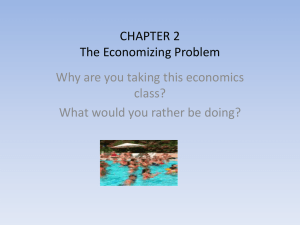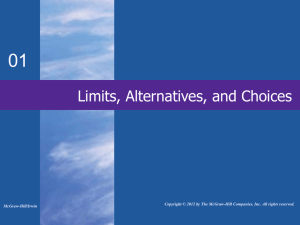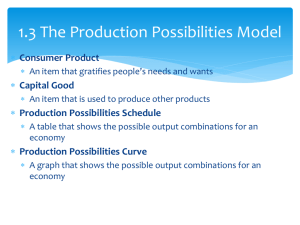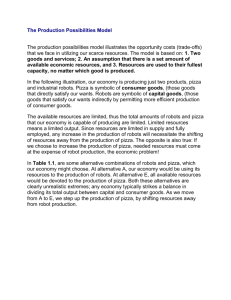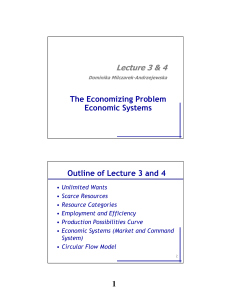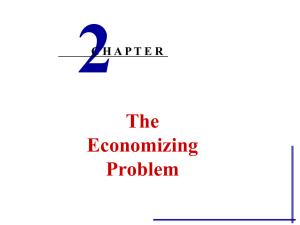in thousands
advertisement
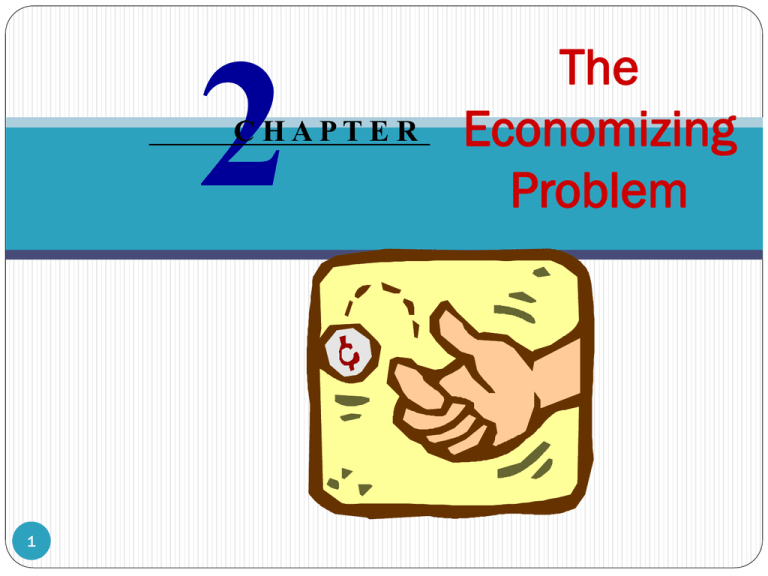
2 C HAPTE R 1 The Economizing Problem The foundation of economics is the economizing problem: wants are unlimited while resources are limited or scarce. Two fundamental facts A. the first fundamental fact: Unlimited wants: 1. Economic wants are desires of people to use goods and services that provide utility, which means pleasure, happiness, or satisfaction. 2 2. Products are sometimes classified as luxuries or necessities, but the division is subjective. 3. Services satisfy wants as well as goods. Businesses and governments also have wants. Over time, wants change and multiply. 4. 5. 3 B. the second fundamental fact: Scarce resources: 1. Economic resources are limited relative to wants. 2. Economic resources are sometimes called factors of production (inputs) and include four categories: a. 4 Land (natural resources), B. Capital or investment goods which are all manufactured aids to production like tools, equipment, factories, transportation, etc., c. Labor or human resources, which include physical and mental abilities used in production (hours). 5 d. Entrepreneur: a special kind of human resource that provides four important functions: Takes the initiative: combining the resources (land, capital and labor to produce a good or a service. ii. Makes Policy Decisions: The non routine decisions that set the course of a business Combines resources needed for production iii. Innovator: commercializes new products, new production techniques or even new forms of a business organization (AMAZON.COM) iv. Bears the risk: of time, effort and funds i. 6 RESOURCE PAYMENTS PROPERTY RESOURCES LAND Rent or Rental Income CAPITAL Interest Income HUMAN RESOURCES LABOR ENTREPRENEUR 7 WAGES PROFIT & LOSS Employment and Efficiency Economics is a science of efficiency in the use of scarce resources. Efficiency requires full employment of available resources and full production. 1. Full employment means all available resources should be employed. 2. Full production means that employed resources are providing maximum satisfaction of our economic wants. Underemployment occurs if this is not so. 8 PRODUCTION POSSIBILITIES A Consumer Good 9 for example... PRODUCTION POSSIBILITIES A Capital Good 10 PRODUCTION POSSIBILITIES in table form PIZZA 0 1 2 3 4 9 7 4 0 (in hundred thousands) ROBOTS (in thousands) 12 10 PRODUCTION POSSIBILITIES in table form PIZZA 0 1 2 3 4 9 7 4 0 (in hundred thousands) ROBOTS 10 (in thousands) 13 (thousands) Robots graphical form Pizzas (hundred thousands) PRODUCTION POSSIBILITIES in table form PIZZA 0 1 2 3 4 9 7 4 0 (in hundred thousands) ROBOTS 10 (in thousands) 14 (thousands) Robots graphical form Pizzas (hundred thousands) PRODUCTION POSSIBILITIES in table form PIZZA 0 1 2 3 4 9 7 4 0 (in hundred thousands) ROBOTS 10 (in thousands) 15 (thousands) Robots graphical form Pizzas (hundred thousands) PRODUCTION POSSIBILITIES in table form PIZZA 0 1 2 3 4 9 7 4 0 (in hundred thousands) ROBOTS 10 (in thousands) 16 (thousands) Robots graphical form Pizzas (hundred thousands) PRODUCTION POSSIBILITIES in table form PIZZA 0 1 2 3 4 9 7 4 0 (in hundred thousands) ROBOTS 10 (in thousands) 17 (thousands) Robots graphical form Pizzas (hundred thousands) PRODUCTION POSSIBILITIES in table form PIZZA 0 1 2 3 4 9 7 4 0 (in hundred thousands) ROBOTS 10 (in thousands) 18 (thousands) Robots graphical form Pizzas (hundred thousands) PRODUCTION POSSIBILITIES Limited Resources means a limited output... At any point in time, a full-employment, fullproduction economy must sacrifice some of product X to obtain more of product Y. 19 Choices will be necessary because resources and technology are fixed. A production possibilities table illustrates some of the possible choices. A production possibilities curve is a graphical representation of choices. 1. Points on the curve represent maximum possible combinations of robots and pizza given resources and technology. 2. Points inside the curve represent underemployment or unemployment. 3. Points outside the curve are unattainable at present. 20 Optimal or best product-mix: 1.It will be some point on the curve. 2.The exact point depends on society; this is a normative decision. 21 PRODUCTION POSSIBILITIES Robots (thousands) Q 14 13 12 11 10 9 8 7 6 5 4 3 2 1 Unattainable A C W Attainable & Efficient D Attainable but Inefficient E 1 22 B 2 3 4 5 6 7 Pizzas (hundred thousands) 8 Q PRODUCTION POSSIBILITIES Robots (thousands) Q 14 13 12 11 10 9 8 7 6 5 4 3 2 1 Notes... Unattainable LAW OF INCREASING A OPPORTUNITY COSTS B The amount of other C W products that must be forgone or D sacrificed to Attainable obtain 1 unit of a specific product is called the & Efficient Attainable opportunity cost of that but good. Inefficient E 1 23 2 3 4 5 6 7 Pizzas (hundred thousands) 8 Q PRODUCTION POSSIBILITIES Robots (thousands) Q 14 24 13 12 11 10 9 8 7 6 5 4 3 2 1 Notes... Unattainable LAW OF INCREASING A OPPORTUNITY COSTS B A graph of the production C possibilities curve W will be CONCAVE - bowed out from D Attainable the origin. & Attainable Economic resources are but not completely adaptInefficient able to other uses. Efficient 1 7 E 2 3 4 5 6 Pizzas (hundred thousands) 8 Q E. Law of increasing opportunity costs: 1.The amount of other products that must be foregone to obtain more of any given product is called the opportunity cost. 2.Opportunity costs are measured in real terms rather than money (market prices are not part of the production possibilities model). 3.The more of a product produced the greater is its (marginal) opportunity cost. 4.The slope of the production possibilities curve becomes steeper, demonstrating increasing opportunity cost. This makes the curve appear bowed out, concave from the origin. 25 Economic Rationale: a. Economic resources are not completely adaptable to alternative uses. b. To get increasing amounts of pizza, resources that are not particularly well suited for that purpose must be used. Workers that are accustomed to producing robots on an assembly line may not do well as kitchen help. How does society decide its optimal point on the production possibilities curve? 26 Unemployment, Growth, and the Future Unemployment and productive inefficiency occur when the economy is producing less than full production or inside the curve (point U in the following figure). In a growing economy, the production possibilities curve shifts outward: 1.when resource supplies expand in quantity or quality. 2.when technological advances are occurring. 27 PRODUCTION POSSIBILITIES Robots (thousands) Q 14 Unemployment & Underemployment Shown by Point U 13 12 11 10 9 8 7 6 5 4 3 2 1 1 28 More of either or both is possible U 2 3 4 5 6 7 Pizzas (hundred thousands) 8 Q PRODUCTION POSSIBILITIES Robots (thousands) Q 14 13 12 11 10 9 8 7 6 5 4 3 2 1 Notes...Unemployment Economic Growth & Underemployment The ability to produce by- Point U a largerShown total output a rightward shift of the production More of either or U possibilities curve caused by...both is possible 1 29 2 3 4 5 6 7 Pizzas (hundred thousands) 8 Q PRODUCTION POSSIBILITIES Robots (thousands) Q 14 13 12 11 10 9 8 7 6 5 4 3 2 1 Notes...Unemployment Economic Growth & Underemployment 1 – Increase in resource supplies Shown by Point U 2 – Better resource U quality More of either or both is possible 3 – Technological advances 1 30 2 3 4 5 6 7 Pizzas (hundred thousands) 8 Q PRODUCTION POSSIBILITIES Robots (thousands) Q 14 A’ 13 12 11 10 9 8 7 6 5 4 3 2 1 C’ D’ E’ 1 31 Economic Growth B’ 2 3 4 5 6 7 Pizzas (hundred thousands) 8 Q Present choices and future possibilities: Using resources to produce consumer goods and services represents a choice for present over future consumption. Using resources to invest in technological advances, education, and capital goods represents a choice for future over present goods. The decision as to how to allocate resources in the present will create more or less economic growth in the future. (See for example Global Perspective 2-1 where various countries are compared with respect to their economic growth rates relative to the share of GDP devoted to investment.) D.A Qualification: International Trade 1. A nation can avoid the output limits of its domestic Production Possibilities through international specialization and trade. 2. Specialization and trade have the same effect as having more and better resources of improved technology. 32 PRODUCTION POSSIBILITIES Two Examples of Economic Growth Goods for the Future ALTA - FAVORS PRESENT GOODS CURRENT CURVE FUTURE CURVE CONSUMPTION Goods for the Present 33 Alta PRODUCTION POSSIBILITIES Two Examples of Economic Growth CURRENT CURVE FUTURE CURVE CONSUMPTION Goods for the Present 34 Alta ZORN - FAVORS FUTURE GOODS Goods for the Future Goods for the Future ALTA - FAVORS PRESENT GOODS CONSUMPTION FUTURE CURVE CURRENT CURVE Goods for the Present Zorn Economic systems Economic systems differ in two important ways: Who owns the factors of production and the method used to coordinate economic activity. A. The market system: 1. 2. 3. 4. 35 There is private ownership of resources. Markets and prices coordinate and direct economic activity. Each participant acts in his or her own self-interest. In pure capitalism the government plays a very limited role. Economic systems B. Command economy, socialism or communism: 1. There is public (state) ownership of resources. 2. Economic activity is coordinated by central planning. C. Mixed economy 36 Chapter 3 INDIVIDUAL MARKETS: DEMAND & SUPPLY Coming Soon… 37
